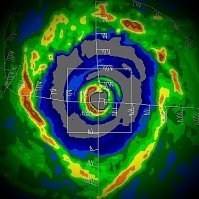-
Posts
4,715 -
Joined
-
Last visited
Content Type
Profiles
Blogs
Forums
American Weather
Media Demo
Store
Gallery
Everything posted by Windspeed
-
-
A low pressure system SSE of the Italy/Anatolia Peninsula in the Ionian Sea has become warm core and acquired TC characteristics. It has a nascent eye feature and good banding, likely producing strong TS force sustained winds and potential hurricane gusts. It is forecast to make landfall in Greece. Translation from Meteo EU: https://weather.us/satellite/ionioi-nisoi/satellite-hd-5min/20200917-1145z.html
-
A low pressure system over the far eastern Atlantic, 99L, is transitioning more warm core with time. It would of course be fitting for 2020 if a Subtropical Storm grabs the last seasonal name prior to the Greek alphabet. lol... Perhaps 90L can get its act together in short order today and snatch the name away. The race is on...
-
Recon is scheduled for today. By the time they get there, this may be a depression or even a TS. Thunderstorm activity has continued to increase and become better organized this morning in association with a well-defined low pressure system located over the southwestern Gulf of Mexico. Upper-level winds are gradually becoming more conducive for development and, if this recent development trend continues, a tropical depression or a tropical could form later today. The low is expected to meander over the southwestern Gulf of Mexico for the next day or so before moving slowly northward to northeastward on Friday and Saturday. An Air Force Reserve reconnaissance aircraft is scheduled to investigate the disturbance this afternoon. * Formation chance through 48 hours...high...90 percent. * Formation chance through 5 days...high...90 percent.
-
ACE isn't the only standard though. People who only consider it to be are foolish. Landfalls are critical data. Cost is important data. Number of storms are critical data. However, ACE shouldn't be done away with as it is an important climatological tool for measuring and comparing basins. Also, it's a great data filter for finding the most active seasons. It's no coincidence that seasons with the highest ACE had numerous powerful TCs beyond just having a high total number of TCs. You also usually find some real long-tracking beasts as well.
-
I don't really pay the ops too much mind for intensity. Sure, it's eye-opening when they go bonkers on a particular system. You do want it to show a deep versus shallow feature, especially in the mid-levels. But generally the global ops have underperformed on intensity for systems that have not yet developed this year. Of course the TC models handle that better once a TCG has occurred however, which what they are better designed for.
-
Well we should have some recon flights during peak since it will eventually be a land threat (Bermuda or possibly NE/NS, etc). You're probably meaning on the ground in situ though. I bet you had no love for Lorenzo. [emoji17]
-
Teddy has a shot at Cat 5. It'll be moving over 29°C SSTs tomorrow within a divergent environment. Definitely going to be a Category 4 and most likely a high end one during its life cycle.
-
Well that's not good.
-
Going ahead with a thread for 90L. It already has the appearance on visible in the lower level cloud field of possessing a closed surface low. This may get classified by this evening and be a landfall threat in Mexico or possibly S. Texas. Another slow mover and flooding threat.
-
ACE is now skyrocketing. We should be over 100 sometime next week.
-
Hrmm...
-
I wasn't referring to nuking a hurricane. That in itself is ridiculous. I was referring to the discussion that delved more into storm manipulation by whatever technological means available. There would be consequences and liability issues. Just to be clear, I am not saying we yet have any such capability / technological advancement to manipulate a hurricane or large weather system. It's merely speculation within the confines of a hypothetical what if scenario. The cloud seeding projects in the past might still be all we've managed to experiment with any success or failure.
-
Liability is a bitch.
-
Ya well we're not going off topic and none of this is proven, only speculation. But I am pretty damn certain that if it could be proven that you redirected a macro-level atmospheric system that caused immense human suffering elsewhere, you're opening up a can of worms no financial institution wants to eat. Nothing withstanding the global ramifications and possible resulting sanctions or war.
-
You got something better? That's the rub. Even the best model guidance is sometimes difficult in its usefulness. That's where good old fashioned synoptic-scale forecasting helps. And that can still be off. There's a reason those folks at the NHC are the cream of the crop. Yet they're still not perfect. Neither is the best modeling based on the most powerful super CPU clusters. Hopefully you can just afford some patience and let it play out / unfold.
-
Simply put, it's too much airmass to manipulate. And here is the catch 2020. Excuse the pun. Let's say you successfully manipulate a storm. At that point you are responsible for it. If the diversion of this atmospheric phenomenon creates another atmospheric phenomenon that wipes out a city, much less kills a bunch of folks, then it's no longer an Act of God, but a result of your screw up.
-
Jesus christ, you could unleash the entire nuclear arsenal and the hurricane would just advect the radioactive wv induced lapse rates and keep on chugging. If nothing else the heat from the detonations might increase evaporation? As for the rest... We humans seem to suck at climate engineering beyond royally fubar'ing everything 1,000,000 x10³.
-
ECMWF ensemble consensus is still the best for tracking, period. Sure, they still miss. But there is a reason we still chew nails awaiting their rums.
-
If that run were to verify, the hypothetical Caribbean/EGOM system would've been Teddy. The GFS does a weird monsoonal split and breaks off the upper axis first that becomes Sally. It then allows the southwestern extension to close off into Teddy and it gets captured by strong ridging / easterly flow. Sally merges with CATL troughing. Teddy drives into the CONUS. Meh...looks gimmicky and likely to not model that way in future op runs with any consistency.
-
Four consecutive ENS runs with overwhelming support for a low latitude CV hurricane next week. Paulette and Rene both recurve. Paulette feels the WAR somewhat and recurves late. That may need to be watched for Bermuda. At any rate, the WAR is modeled with good ensemble support following exit and lift of the ECONUS shortwave. If the next AEW is as organized as modeled, it's going to have a shot at running the entirety of the MDR without a TUTT in place. There might be some backside upper influences of a stronger Paulette in the mid-range. However, with an EATL cutoff, most downstream upper 200 hPa flow would likely divert eastward. Simply put, next week may very well be prime time for a legitimate long-tracking major hurricane if it's going to be a reality this season. Additionally, the WPAC is entering a period of quiescence. Combining both quiet WPAC and EPAC basins, the N. Atlantic's upper tropospheric setup for the next 2-3 weeks likely supports several long-trackers. Additionally, the MJO is in a phase that is more supportive of eastern MDR development and would favor TCG becoming more frequent east of 50ºW. You do not need 200 hPa vorticity anomalies in the WATL if you already have established westward tracking TCs. Their anticyclones will take care of themselves barring negative TUTT/PV interaction. So as we progress through the next 2-3 weeks, tracking patterns are going to be key here. Where are the shortwaves versus ridges and what are their timings with potential TCs? We're going to have several recurves, no doubt. But if a few TCs form at low latitudes or time as a trough kicks out, I'd say the Antilles, Caribbean, Bahamas and SECONUS will have several threats by the time we enter October. Another thing to keep in mind is the pattern setup and MDR systems may last through mid-October. The past five years have seen later dates in MDR development versus climatological mean. Considering that we have a strengthening La Niña and positive AMO, this year may continue that trend.





